Table potato variety “Krepysh” for temperate climates
Krepysh is a relatively young potato variety. Thanks to its taste characteristics and ease of care, it has already become a favorite among many farmers. The fortress is successfully cultivated both on personal plots and for industrial purposes.
Potato Krepysh - description of the variety
Krepysh - table potato variety. When heat treated, the tubers do not crumble or change color; they are suitable for frying, baking, making soups and French fries. This variety is often grown commercially for sale or processing of tubers into potato products.
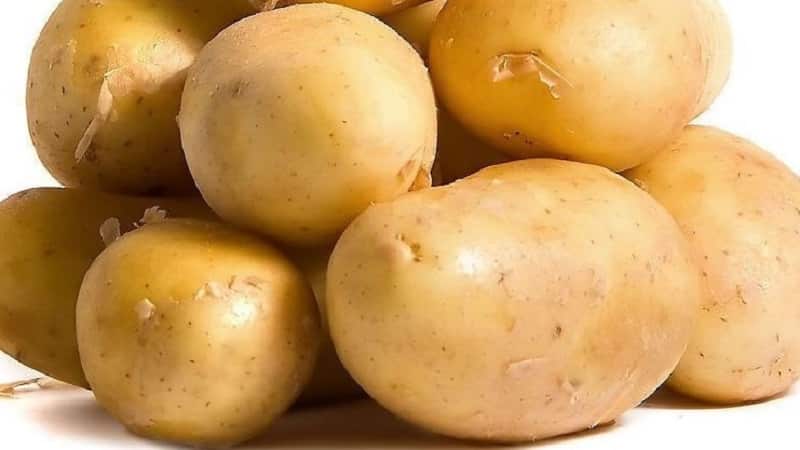
Origin and development
The Krepysh potato is the result of breeding work by scientists at the All-Russian Research Institute of Potato Farming named after A. G. Lorch.
The variety was bred at the beginning of the 21st century. The numbered hybrid 2953-34 and the variety Shurminsky-2 were chosen as parent plants.
Reference. Krepysh was included in the State Register of Breeding Achievements in 2005.
Chemical composition, trace elements and vitamins
Krepysh potato tubers contain 10-12% starch, as well as vitamins B6 and C, potassium, copper, manganese, phosphorus, nicotinic and pantothenic acids, dietary fiber, phytonutrients, carotenoids, flavonoids and unique proteins.
Ripening period
Krepysh belongs to early ripening potato varieties. After planting the planting material, it takes 60-80 days for the tubers to fully ripen, but the first harvest can be harvested after 45 days.
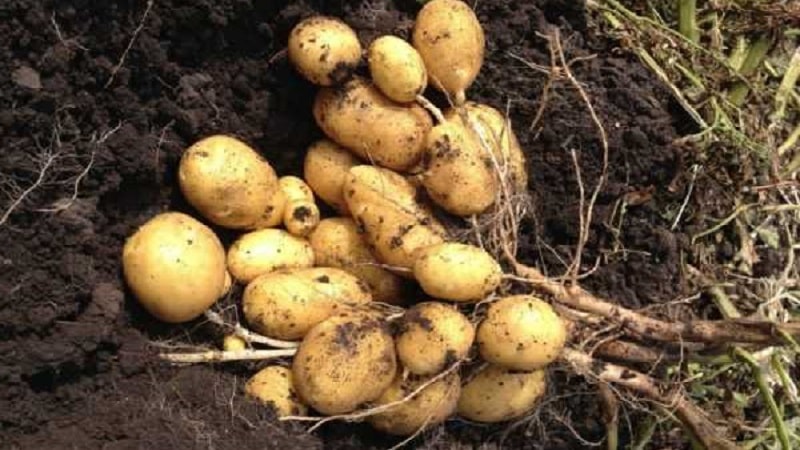
Productivity
Subject to compliance with agrotechnical requirements, they collect from one bush 15-20 tubers, and the average commercial yield per 1 hectare of land reaches 127-242 c.
At the first digging (on the 45th day after germination), the yield is 120-195 c/ha, at the second (55th day) - 164-275 c/ha.
Reference. In the Moscow region, the maximum yield was recorded - 276 c/ha.
Disease resistance
The variety is resistant to golden cyst nematode, scab and potato blight., however, it has practically no immunity to late blight and other fungal diseases: fusarium, rhizoctonia, alternaria, blackleg.
Characteristics of tubers, description of appearance
The bushes are erect, medium-sized, reaching a height of 60 cm. The leaves are medium in size, green or dark green in color, with slightly wavy edges.
During the flowering period, which lasts about 2 weeks, quite large bright purple flowers with a red tint appear on the bushes.
Oval, oblong tubers, weigh on average 80-105 g, covered with thin and smooth yellow skin. The eyes are located sparsely, at an average depth.
Cream colored pulp, has a delicate taste, without wateriness. Retains shape and color during cooking.
For which regions is it best suited?
The Krepysh variety is unpretentious to soil composition and climate, therefore successfully cultivated in Moldova, Ukraine and all regions of Russia, including:
- Northern;
- Northwestern;
- Central;
- Central Black Earth;
- Far Eastern.
The main advantages and disadvantages of the variety
The main advantages of the Krepysh variety include:
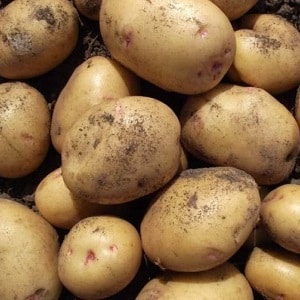 early maturation;
early maturation;- abundant yield;
- drought resistance;
- pleasant taste;
- good keeping quality and transportability;
- immunity to a number of diseases;
- unpretentiousness to soil composition, climatic conditions and maintenance;
- low starch content.
Among the disadvantages are:
- tendency to be affected by late blight;
- the need for hilling and fertilizing;
- the likelihood of damage to the crop if the root crops are not sufficiently dried after digging.
What is the difference from other varieties
| Variety | Ripening time | Productivity, c/ha | Starch content, % | Weight of marketable tubers, g | Keeping quality, % |
| Sturdy | 70-80 days | 127-242 | 10-12 | 80-105 | 97 |
| Innovator | 75-85 days | 320-330 | Up to 15 | 120-150 | 95 |
| Riviera | 40-80 days | Up to 450 | 12-16 | 100-180 | 94 |
| Gala | 75-80 days | Up to 700 | 14-16 | 100-140 | 85-90 |
| Zhukovsky early | 60-70 days | 400-450 | 10-12 | 100-120 | 92-96 |
| Antonina | 60-70 days | 210-300 | 15,9-19,4 | 100-150 | 95 |
Other early potato varieties:
Features of planting and growing
Cultivating potatoes, and in particular the Krepysh variety, does not require much effort. At the same time, it is important to know some features and nuances regarding the choice of location, compliance with crop rotation, planting dates and preparation of seed.
Preparing for landing
First of all, it is necessary to select high-quality planting material. Last year's tubers are suitable, but 14-20 days before planting they must be transferred for germination to a well-lit and ventilated place with a temperature of +18...+20°C.
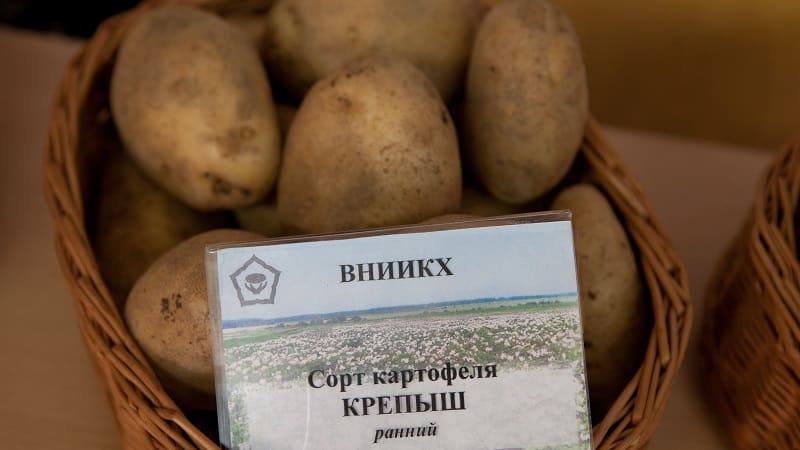
The day before planting, the tubers are disinfected and treated with fungicides. You can also keep them in a solution of growth stimulants (Epin, Kornevin), which will have a beneficial effect on the yield and resistance of potatoes to diseases.
Preparation of the selected site begins in the fall. The soil must be dug up, weeds, roots and stones must be removed, and organic fertilizers must be added to the soil: manure, chicken droppings, wood ash, compost.
In the spring, digging is repeated and apply mineral fertilizers, which include nitrogen, potassium, phosphorus, calcium and manganese.
Soil requirements
Potato The fortress is undemanding to the soil, but still grows better in loose, light soil, having neutral or weak acidity, good aeration and moisture permeability.
If the soil on the site is too heavy, it is diluted by adding 3-4 kg of sand, 2-3 kg of peat and 7-8 kg of humus per 1 m² during autumn digging. Reduce the acidity of the soil by adding wood ash (about 400 g per 1 m²).
Dates, scheme and rules of planting
In early or mid-May, potatoes are planted in open ground to a depth of 10-12 cm. It is important that the earth warms up to +8...+10°C.
Krepysh planting scheme:
- Form even beds on a pre-prepared area, the distance between them is 60-65 cm.
- Dig holes at a distance of 30-35 cm from each other.
- Moisten the holes with water and place a tuber in each hole with the eyes facing up.
- Level the beds and mulch (cover with straw).
When planting in loose and airy soil, the tubers are buried 15 cm, in light and slightly damp - by 10 cm, and in heavy and wet - by 5 cm.
Reference. It is not recommended to apply organic fertilizers to planting holes. This will cause the potatoes to become watery and have a bitter taste.
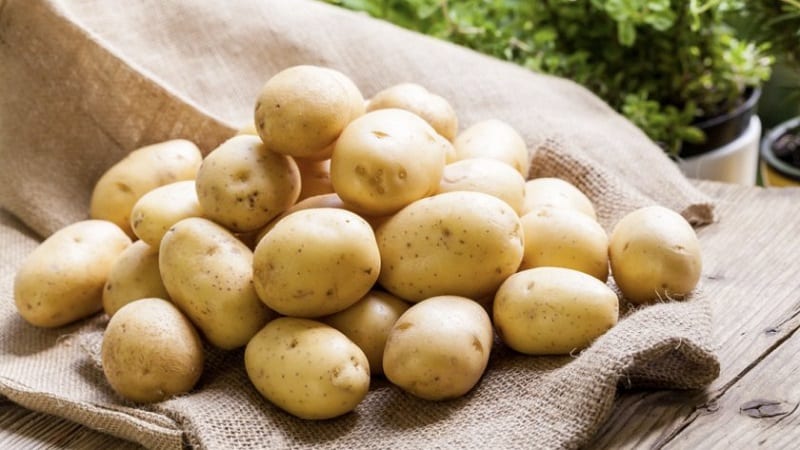
Features of cultivation
When growing the Krepysh variety follow a few important rules:
- You cannot plant a crop in the same area 2 times in a row - potatoes require an annual change of location.
- It is best to plant this variety after legumes and other green manures.
- For planting, select well-lit areas located on the plain or a small hill.
Nuances of care
Despite the fact that Krepysh is an unpretentious variety, there are some agrotechnical norms and rules, the observance of which will ensure an abundant and high-quality harvest.
Watering mode
Potato Krepysh is undemanding when it comes to watering. Under favorable weather conditions It is enough to water the bushes 3 times per season:
- when the sprouts reach a height of 20 cm;
- during budding;
- after flowering.
Generally focus on soil conditions. Watering will be required when the soil dries to a depth of 15 cm. To do this, use settled or rain water, pouring 3 liters under each bush. It is important to pour water exactly at the root, making sure that it does not get on the leaves, which can lead to the development of late blight.
Reference. If the air temperature is too high, spray the leaves, but do not allow moisture to accumulate on them.
Top dressing
To ensure maximum productivity, During the season you need to feed the plants 3 times:
- twice with organic fertilizers - mullein infusion, bird droppings, humus;
- 1 time with minerals, which do not contain a lot of nitrogen - preferably copper-containing preparations.
Weeding and hilling
Potato tubers of this variety develop at a depth of no more than 17 cm, therefore it is necessary to frequently earth up the bushes so that the harvest is abundant and of high quality.
Hilling is carried out for the first time, when the seedlings reach a height of 20 cm, then after 2 weeks and the last time - after about another 20-22 days. The bushes are sprinkled so that 2-3 pairs of leaves remain on the surface.
Also Weed regularly, removing weeds that take away nutrients from potato sprouts. On average, the soil between the rows should be weeded every 10-14 days.
Disease and pest control
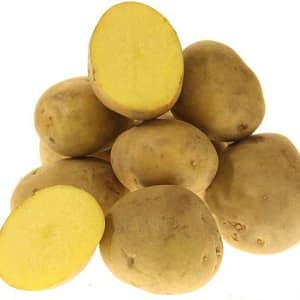 If signs of disease are found on potato bushes, remove all damaged areas of plants, and then treat the bushes with fungicidal antifungal drugs. The most commonly used are Ridomil Gold, Fitosporin, Maxidom or Kuproksat, which should be diluted in accordance with the instructions.
If signs of disease are found on potato bushes, remove all damaged areas of plants, and then treat the bushes with fungicidal antifungal drugs. The most commonly used are Ridomil Gold, Fitosporin, Maxidom or Kuproksat, which should be diluted in accordance with the instructions.
Among insect pests most often the bushes of Krepysha attack Colorado potato beetles, black aphids, wireworms and mole crickets. To combat them, broad-spectrum insecticides are used: “Commander”, “Karbofos”, “Fitoverm”, “Calypso”, “Vermitek”, “Aktellik”.
To prevent the development of diseases and pest attacks, potato bushes are sprayed from the beginning of the growing season until the flowering period.
Important! The last treatment of potatoes with chemicals is carried out at least 20 days before harvest.
Harvest and storage
The readiness of the crop for harvesting is judged by the blackened and drying tops.
How and when to collect
Potatoes are dug up 45 days after sprouts appear.when warm and dry weather sets in. It is advisable to wait a few more weeks for complete ripening.
Harvesting in two ways:
- Traditional - completely removing bushes from the soil.
- Lengthy - separating the largest tubers from the bushes, and leaving smaller ones to ripen for 2-3 weeks. Using this method, you can double your harvest.
Storage features and keeping quality of the variety
The collected tubers are dried in the sun for several hours, then carefully sort through. Rotten and damaged specimens are disposed of.
Whole and tubers suitable for storage are placed in bags or wooden boxes and put in a dark, well-ventilated and dry room with an air temperature of +1...+4°C.
Reference. To disinfect the premises, the walls are whitewashed.
Provided proper storage Krepysh potatoes do not lose their presentation and taste until the end of spring. The keeping quality of the variety is up to 97%.
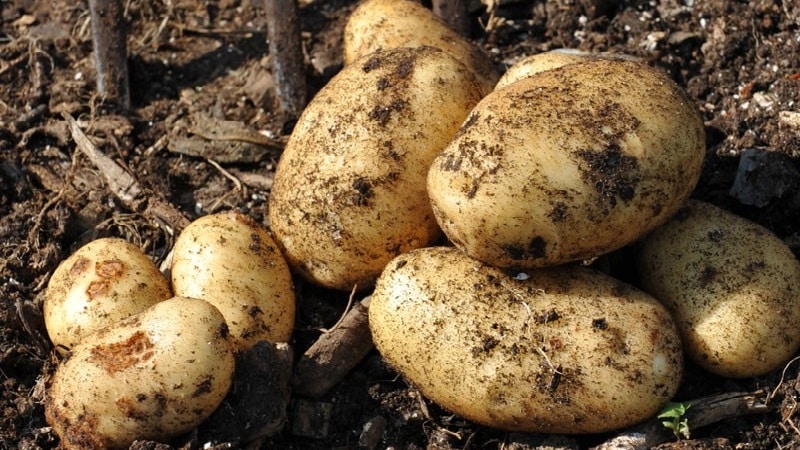
What difficulties may there be when growing
Sometimes Growing the Krepysh variety is accompanied by certain difficulties:
- The development of late blight or other fungal diseases - often due to improper watering or non-compliance with crop rotation.
- Rotting of the seed when tubers are planted too early in unheated soil.
- Poor germination due to planting ungerminated seeds.
- Pest attacks as a result of neglect of preventive spraying.
Advice from experienced gardeners and reviews about the Krepysh variety
Advice from experienced farmers that will help you get a high-quality and abundant harvest:
- Plant potatoes only in well-warmed soil, otherwise the tubers will rot.
- Change the location for planting potatoes every year.
- Be sure to spray the bushes to prevent diseases and pest attacks.
- Keep an eye on watering. Do not allow water to get on the leaves - this will lead to the development of late blight and the death of most of the crop.
Krepysh is a young variety that has already become a favorite among many gardeners., which is confirmed by positive reviews.
Valentina, Vologda region.: “I grow potatoes at the dacha, a couple of years ago I decided to plant Krepysh and was not disappointed. What attracted me most was the variety’s ability to tolerate short-term drought, because I can only come to the dacha once a week. The yield is encouraging - we have more than enough for two large families.”.
Nikolay, Tver: “Strong is a telling name for this variety. The tubers are large, beautiful, the harvest is rich - enough for yourself and for sale.I store potatoes in the cellar, but in mid-April it becomes humid there, so I move the leftovers to a drier place. I hill up with a mini-cultivator - it’s very convenient.”.
Conclusion
Krepysh is an early ripening potato variety suitable for cultivation in any region of Russia. Among its advantages are high yield, unpretentiousness to soil, care and climate, as well as pleasant taste, high commercial quality and good shelf life.